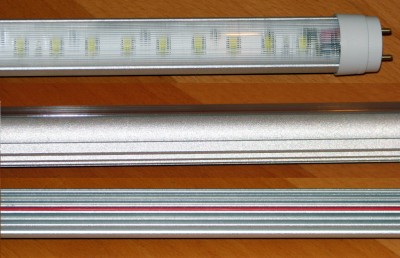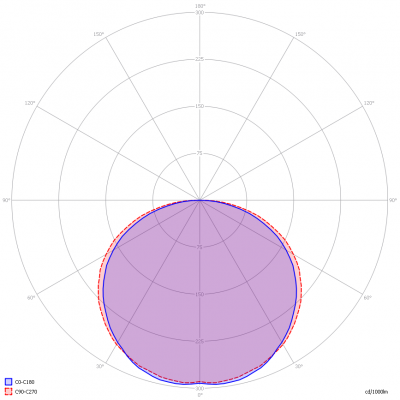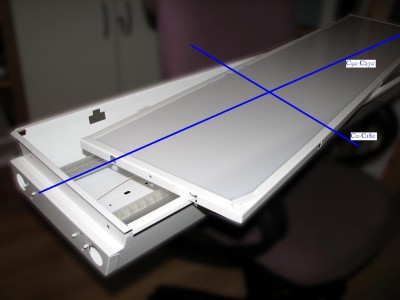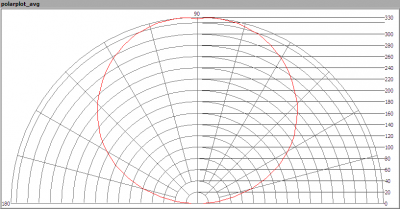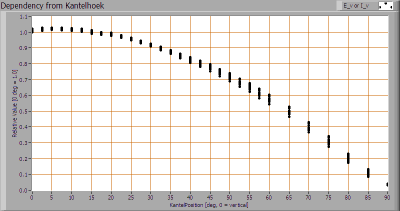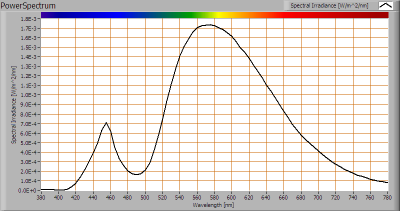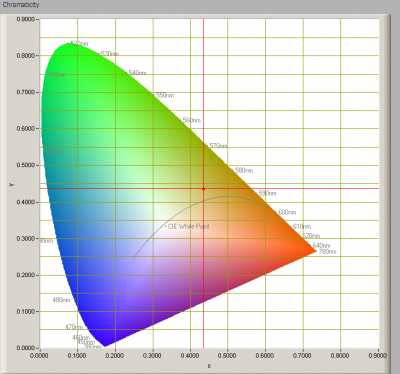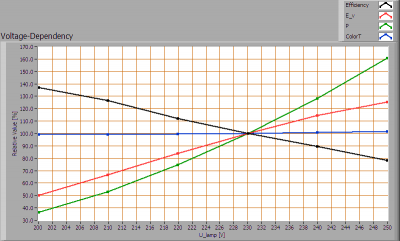LLE smd LED 3000K 120cm double built-in luminaire milky
Posted by Marcel van der Steen in Led lights, Light measurements No Comments» presents a measurement set of two 1200 mm smd-LED tubes inside a built-in luminaire that has a milky plate. In this article the measurement data can be found as well as in Eulumdat format.
See this overview for a comparison with other light bulbs.
Summary measurement data
| parameter | meas. result | remark |
|---|---|---|
| Color temperature | 3325 K | Close to warm white |
| Luminous intensity Iv | 331 Cd | |
| Beam angle | 129 deg | A wide beam, which is to be expected from an FL-tube. Also the milky plate takes care of this wide angle. |
| Power P | 49.7 W | |
| Power Factor | 0.88 | For every 1 kWh net power consumed, there has been 0.55 kVAhr for reactive power. |
| Luminous flux | 1122 lm | |
| Luminous efficacy | 23 lm/W | |
| CRI_Ra | 67 | Color Rendering Index. |
| Coordinates chromaticity diagram | x=0.434 and y=0.437 | |
| Fitting | FL-tube | |
| L x W x H external dimensions | 1220 x 300 x 87 mm | External dimensions of the built-in luminaire |
| L x W dimensions luminous area | 1175 x 278 mm | Dimensions of the luminous area (used in Eulumdat file). This is the area of the milky plate. |
| General remarks | The ambient temperature during the whole set of measurements was 23.0 deg C.
Warm up effect: small effect, the temperature of the tube was not yet stable after 30 minutes. Voltage dependency: consumed power and illuminance are dependent from the light bulb voltage. It is a linear dependence. For the eulumdat file follow this link. |
The light tube
The led tubes use smd LEDs. At the back side of the tube the ribs of the aluminum heatsink are visible. These tubes are robust and heavy tubes.
At the top the front view, then side view and at bottom the back view.
Eulumdat lichtdiagram
With this article an eulumdat file is added. This is a file that a.o. indicates the radiation pattern around the light bulb. There are more parameters in the file, and these all can be read with help of the free open source program Qlumedit.
An interesting graph is the light diagram, indicating the intensity in the C0-C180 and the C90-C270 plane.
The light diagram giving the radiation pattern in the C0-C180 and C90-C270 planes.
The C0-C180 plane is perpendicular to the length axis of the tube. It indicates the luminous intensity sideways of the tube.
The C90-C270 plane indicates the radiation pattern in the plane in the same direction as the tube’s length.
Illuminance Ev at 1 m distance, or luminous intensity Iv
Herewith the plot of the averaged luminous intensity Iv as a function of the inclination angle with the light bulb.
The radiation pattern of the light bulb.
This radiation pattern shows a wide beam. The milky plate results in a very stable decrease of the intensity; it follows a so called cosine rule. This means that with the increasing inclination angle, the intensity decreases with the cosine of the inclination angle.
These averaged values are used (later) to compute the lumen output.
The intensity measurements (of each turn angle) as function of inclination angle.
This plot shows per inclination angle the intensity measurement results for each turn angle at that inclination angle.
When using the average values per inclination angle, the beam angle can be computed, being 129 degrees. However, this value is dependent from the plane observed.
Luminous flux
With the averaged illuminance data at 1 m distance, taken from the graph showing the averaged radiation pattern,it is possible to compute the luminous flux.
The result of this computation for this lamp is a luminous flux of 1122 lm.
Luminous efficacy
The luminous flux being 1122 lm, and the power of the lightbulb being 49.7 W, yields a luminous efficacy of 23 lm/W.
A power factor of 0.88 means that for every 1 kWh net power consumed, a reactive component of 0.55 kVAr was needed.
| Light bulb voltage | 230 V |
| Light bulb current | 245 mA |
| Power P | 49.7 W |
| Apparent power S | 56.5 VA |
| Power factor | 0.88 |
Color temperature and Spectral power distribution
The spectral power distribution of this light bulb.
The measured color temperature is about 3325 K, close to warm white.
Chromaticity diagram
The chromaticity space and the position of the lamp’s color coordinates in it.
The light coming from this lamp is at a distance from the Planckian Locus (the black path in the graph).
Its coordinates are x=0.434 and y=0.437.
Color Rendering Index (CRI) or also Ra
Herewith the image showing the CRI as well as how well different colors are represented (rendered). The higher the number, the better the resemblance with the color when a black body radiator would have been used (the sun, or an incandescent lamp).
Each color has an index Rx, and the first 8 indexes (R1 .. R8) are averaged to compute the Ra which is equivalent to the CRI.
CRI of the light of this lightbulb.
The value of 67 is lower than 80 which is considered a minimum value for indoor usage.
Note: the chromaticity difference is 0.013 indicates the distance to the Planckian Locus. Its value is higher than 0.0054, which means that the calculated CRI result is not meaningful.
Voltage dependency
The dependency of a number of lamp parameters on the lamp voltage is determined. For this, the lamp voltage has been varied and its effect on the following lamp parameters measured: illuminance E_v [lx], color temperature CT or correlated color temperature CCT [K], the lamppower P [W] and the luminous efficacy [lm/W].
Lamp voltage dependencies of certain light bulb parameters, where the value at 230 V is taken as 100 %.
The power consumed and the illuminance measurements depend on the light bulb voltage applied. This dependence is linear.
To check whether this dependency can lead to visible changes in illuminance for possible grid voltage changes, it is noted what variations occur when the lamp voltage varies around 230 V + and – 5 V. Then the illuminance varies between + and – 8 %. It will not be visible.
Warm up effects
After switch on of a cold lamp, the effect of heating up of the lamp is measured on illuminance E_v [lx], color temperature CT or correlated color temperature CCT [K], the lamppower P [W] and the luminous efficacy [lm/W].
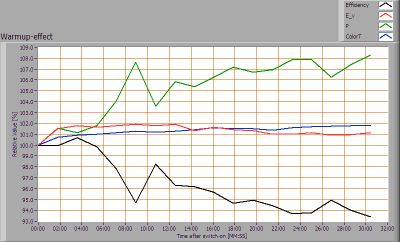
Effect of warming up on different light bulb parameters. The 100 % level is put at begin.
No noticeable effects seen. The temperature is not completely stable after 30 minutes but the rate of change is low at that time.

